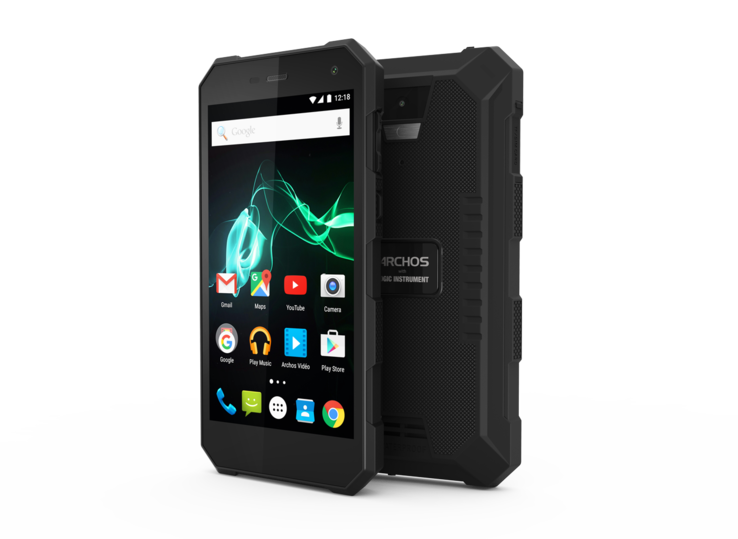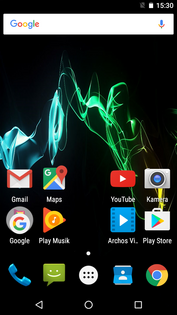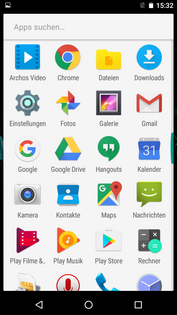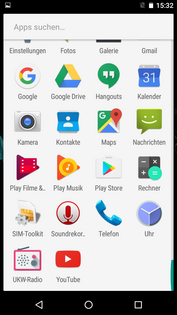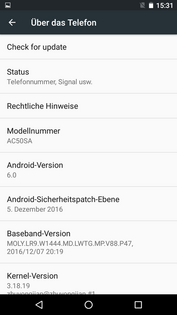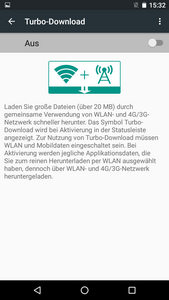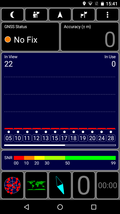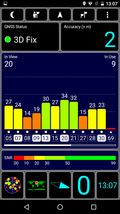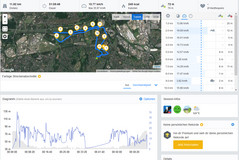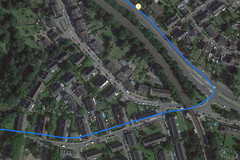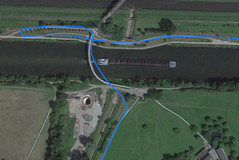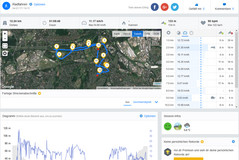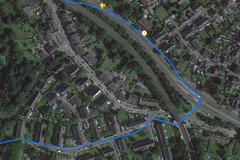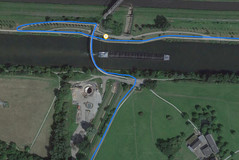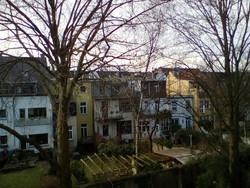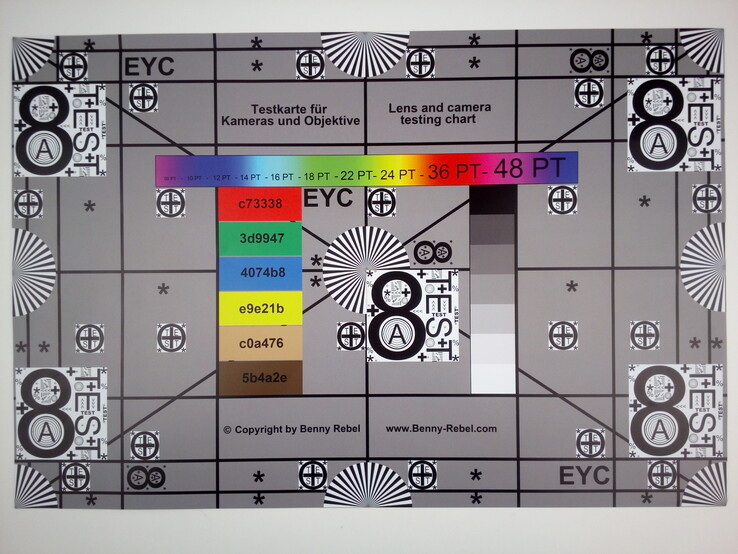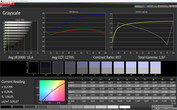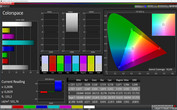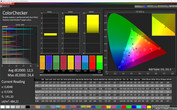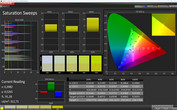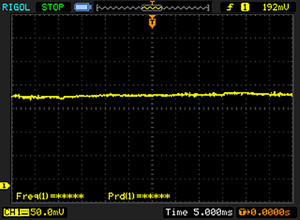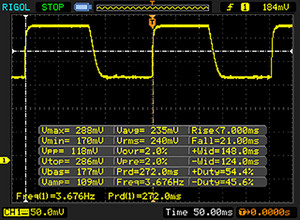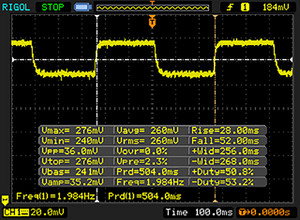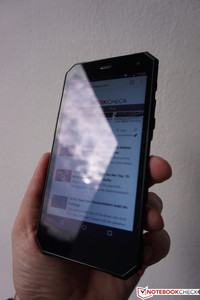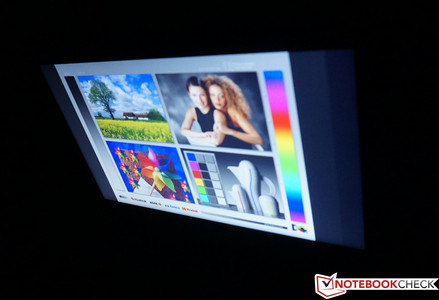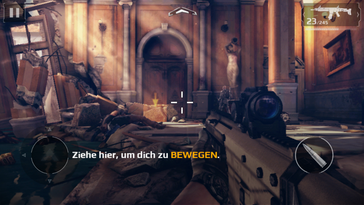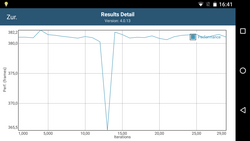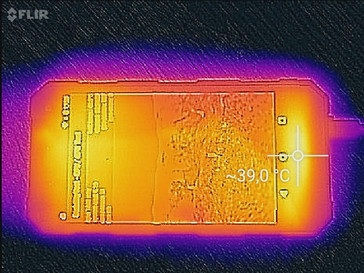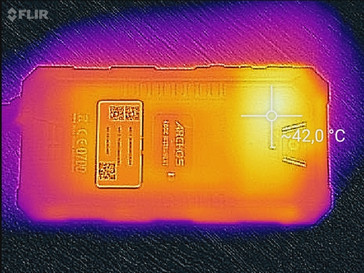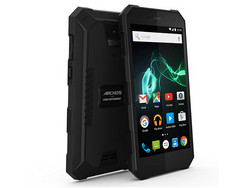Archos 50 Saphir Smartphone Review
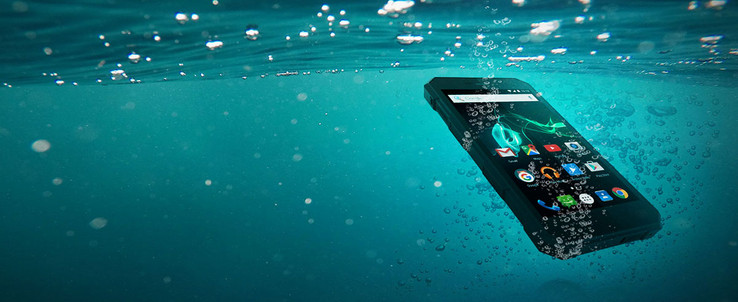
For the original German review, see here.
The 50 Saphir from the French manufacturer Archos is an outdoor smartphone. The device with the bulky chassis is certified according to IP68 standards and the display is covered by Gorilla Glass 4, but the rest of the specifications are in line with an inexpensive mainstream smartphone: 5-inch HD display, quad-core SoC, 2 GB of RAM and 16 GB of storage. The two highlights are the dual SIM support as well as the powerful battery, which enables long runtimes.
The Archos 50 Saphir is priced at around 230 Euros (~$245), so the test model faces some strong competitors. However, currently there are not many outdoor smartphones. One example would be the Panasonic ToughPad FZ-N1 that we reviewed last year, but it is designed for professional users in the industry sector with a retail price of around 2000 Euros (~$2129). Samsung has also announced the new outdoor smartphone Galaxy Xcover 4 for 260 Euros (~$277), which will be launched in about 4 weeks’ time.
We have selected comparison devices with a similar price tag for this review. These include the Honor 5C, the Huawei P8 Lite 2017, the Asus ZenFone 3 Max, the Alcatel Shine Lite, and the still very popular Samsung Galaxy J5 .
Case
We were rather surprised by the very bulky and aggressive chassis design when we saw the smartphone for the first time. This is basically looking like a regular smartphone with a special outdoor case attached. Archos offers the 50 Saphir in black only, and there are sharp edges everywhere; the design does not include any curves.
Both the build quality and the stability of the outdoor specialist are very good. Pressure is no problem at all and we could not provoke any creaking sounds. The whole device leaves a very durable impression and we do not have any doubts that it will survive some drops. At least if it does not land on the screen, because it is "only" protected by Corning's Gorilla Glass 4 and therefore does not differ from many other smartphones. The Archos 50 Saphir is also certified according to IP68 against dust and water (fresh water, up to 1 meter/~3 ft for up to 30 minutes). There are special rubberized covers for the ports, but they are somewhat tricky. They cannot be opened very far, so it is not easy to attach the USB cable at the bottom, for example. It is also possible to use the Archos 50 in warm or cold environments: Archos advertises an operating temperature of between -20 °C (~-4 °F) all the way up to +55 °C (~131 °F). The battery is integrated and not accessible from the outside.
The Archos 50 Saphir has obviously a hard time in our size comparison, which is not surprising. The footprint is still okay, but at 14 millimeters (~0.55 in); it is almost twice as thick as the comparison devices. The weight of 222 grams (~7.8 oz) is noticeable as well. This is no problem in the backpack on your outdoor trip, but the outdoor smartphone is not very convenient in your pocket.
Connectivity
The hardware equipment of the test device is somewhere between an entry-level and mainstream model. The quad-core SoC from Qualcomm is no performance wizard, but is sufficient for everyday tasks. The memory equipment is also okay with 2 GB of RAM and 16 GB of internal storage (10 GB available), especially since the storage can be expanded via microSD card (up to 128 GB). At the bottom of the smartphone is a micro USB 2.0 port with OTG support. It is therefore easy to attach external devices such as USB flash drives.
We check the performance of the card reader with our reference card from Toshiba (Exceria Pro M401), but up to 28 MB/s read and only 18 MB/s write are well below the advertised performance of the card (up to 95 and 80 MB/s, respectively). The card can be formatted either as portable or internal storage. The Archos 50 Saphir also supports two SIM cards (both Nano SIM slots with LTE support). It is a hybrid slot, so you can either use two SIM cards or one SIM-card and a microSD card.
You also get an FM radio, which works in combination with headphones. Connections with other devices can be established via Bluetooth 4.0 or Wi-Fi Direct.
Software
Archos ships the 50 Saphir with Android 6.0 Marshmallow. The French manufacturer waives any modifications, and we did not get a message about the installation of third-party apps during the initial setup, which was sometimes the case with previous models. There is no bloat ware either.
The overall handling of the OS is smooth. An update to Android version 7.0 Nougat has not been announced so far.
Communication and GPS
The Wi-Fi module supports the IEEE 802.11 standards b/g/n in 2.4 GHz networks. 5 GHz networks and the fast ac standard, however, cannot be used. This is also the case for the competition though, and the measured transfer rates of ~50 Mbps are inconspicuous during our standardized WLAN test with the router Linksys EA8500. We did not notice any stability or performance problems with the connection during our review period. The Archos 50 Saphir also supports a feature called "Turbo Download", where the mobile Internet connection is combined with the Wi-Fi connection for larger downloads (more than 20 MB).
Both Nano SIM slots support LTE connections, and we did not experience any issues in the metropolitan T-Mobile network. The number of frequencies is limited, however, so the smartphone is not perfect for globetrotters (see specifications at the top for the full list). The maximum transfer rate is 150 Mbps downstream and 50 Mbps upstream, respectively (LTE Cat.4).
| Networking | |
| iperf3 transmit AX12 | |
| Huawei P8 lite 2017 | |
| Archos 50 Saphir | |
| Asus Zenfone 3 Max ZC520TL | |
| Alcatel Shine Lite | |
| iperf3 receive AX12 | |
| Huawei P8 lite 2017 | |
| Asus Zenfone 3 Max ZC520TL | |
| Alcatel Shine Lite | |
| Archos 50 Saphir | |
The smartphone locates its position via GPS only, and we did not get a signal indoors. Outdoors, however, the app GPS Test determined a very good accuracy of just 2 meters (~6.5 ft). We also checked the performance of the outdoor smartphone on a bicycle ride. The comparison with the professional navigation device Garmin Edge 500 shows a total deviation of around 400 meters (~0.25 mi) on the 12 km (~7.5 mi) long track, and we can see "shortcuts" at some points of the track. This will be sufficient for everyday navigation purposes, but we would have expected a better performance from an outdoor specialist like the Archos 50 Saphir.
Telephone Functions and Voice Quality
The phone app is the usual Google standard and does not offer any special features. We did not have any problems when we used the Archos 50 Saphir for calls, but you can notice some background static in general. The speaker is sufficiently loud and the microphone is not too quiet either. The provided headset does its job, but it is not very sophisticated. The earpieces quickly hurt in our ears, and the microphone is not the loudest. You might want to get a better headset when you frequently use it for calls.
Cameras
The camera at the front takes pictures at up to 5 MP (2560x1920 pixels, fix focus) and videos in Full HD (1920x1080 pixels). Our sample picture on the right was taken in good lighting conditions, but the details are still pretty blurry and the colors are not particularly vivid. Low-light situations will add visible picture noise.
Archos has installed a 13 MP sensor (4864x2736 pixels) with auto focus and LED flash at the back. The maximum video resolution is 1920x1080 pixels (Full HD, 30 fps). Some colors are too saturated (see color comparison below), but the sharpness is okay in a controlled test environment. However, our sample shots suffer from blurry details compared to the rivals, and the pictures are also a bit darker in general (especially scene 2). The result is also slightly darker in low-light scenarios (scene 3), but you can still see everything. You should avoid fast camera movements when you record videos.
Accessories and Warranty
The scope of delivery is limited to the usual accessories: Service leaflets, modular power adapter, USB cable, SIM tool and headset. Archos does not offer any dedicated accessories for the 50 Saphir.
The standard warranty period is 24 months. Please see our Guarantees, Return Policies and Warranties FAQ for country-specific information.
Input Devices and Handling
The capacitive touchscreen recognizes up to 5 inputs simultaneously, which is sufficient in practice. The precision does not cause any criticism and inputs in the peripheral areas are also well-executed. Archos uses the standard Google keyboard. It is easy to use and supports all common features such as swipe gestures as well as auto-correct.
The Android buttons are implemented as virtual controls. We did not like the physical buttons on the right side of the chassis: Both the volume rocker as well as the power button are small and almost require an inconvenient amount of force. You will get used to that after a while, but it is not possible to use them with gloves. There is no special glove-mode for the touchscreen either.
Display
Archos has equipped the 50 Saphir with a 5-inch IPS display. The resolution is 1280x720 pixels and the resulting pixel density of 294 PPI ensures crisp images, but some rivals in this price range are already equipped with Full HD panels.
The outdoor smartphone leaves a good impression in our initial benchmarks. We determine a good average luminance of almost 530 nits, with both the activated brightness sensor as well as the manual control. The black value, however, is pretty high at 0.57 cd/m², and dark contents have a visible gray-hue. The contrast ratio is still good at 940:1, and we did not detect PWM flickering.
| |||||||||||||||||||||||||
Brightness Distribution: 87 %
Center on Battery: 543 cd/m²
Contrast: 940:1 (Black: 0.58 cd/m²)
ΔE ColorChecker Calman: 12.5 | ∀{0.5-29.43 Ø4.78}
ΔE Greyscale Calman: 15.4 | ∀{0.09-98 Ø5}
Gamma: 1.87
CCT: 12705 K
| Archos 50 Saphir IPS, 1280x720, 5" | Honor 5C IPS, 1920x1080, 5.2" | Huawei P8 lite 2017 IPS, 1920x1080, 5.2" | Asus Zenfone 3 Max ZC520TL IPS, 1280x720, 5.2" | Alcatel Shine Lite IPS, 1280x720, 5" | Samsung Galaxy J5 2016 AMOLED, 1280x720, 5.2" | |
|---|---|---|---|---|---|---|
| Screen | 22% | 35% | 24% | 14% | 22% | |
| Brightness middle (cd/m²) | 545 | 515 -6% | 575 6% | 507 -7% | 425 -22% | 289 -47% |
| Brightness (cd/m²) | 527 | 498 -6% | 559 6% | 474 -10% | 406 -23% | 291 -45% |
| Brightness Distribution (%) | 87 | 93 7% | 91 5% | 85 -2% | 90 3% | 96 10% |
| Black Level * (cd/m²) | 0.58 | 0.49 16% | 0.39 33% | 0.53 9% | 0.45 22% | |
| Contrast (:1) | 940 | 1051 12% | 1474 57% | 957 2% | 944 0% | |
| Colorchecker dE 2000 * | 12.5 | 6.2 50% | 5.2 58% | 4.7 62% | 7.6 39% | 4.7 62% |
| Colorchecker dE 2000 max. * | 24.4 | 11.4 53% | 10.3 58% | 7.2 70% | 15.6 36% | 7.3 70% |
| Greyscale dE 2000 * | 15.4 | 7.4 52% | 7.2 53% | 4.8 69% | 6.6 57% | 3 81% |
| Gamma | 1.87 118% | 2.28 96% | 2.4 92% | 2.25 98% | 2.44 90% | 2.03 108% |
| CCT | 12705 51% | 8664 75% | 7224 90% | 6441 101% | 7853 83% | 6291 103% |
* ... smaller is better
The screen suffers from a visible blue cast and the DeltaE-2000 deviations of the grayscale and the colors compared to the sRGB reference are also quite high. The color temperature is too cool and the gamma value is also too low.
Screen Flickering / PWM (Pulse-Width Modulation)
| Screen flickering / PWM not detected | |||
In comparison: 53 % of all tested devices do not use PWM to dim the display. If PWM was detected, an average of 8111 (minimum: 5 - maximum: 343500) Hz was measured. | |||
Display Response Times
| ↔ Response Time Black to White | ||
|---|---|---|
| 28 ms ... rise ↗ and fall ↘ combined | ↗ 7 ms rise | |
| ↘ 21 ms fall | ||
| The screen shows relatively slow response rates in our tests and may be too slow for gamers. In comparison, all tested devices range from 0.1 (minimum) to 240 (maximum) ms. » 70 % of all devices are better. This means that the measured response time is worse than the average of all tested devices (20.2 ms). | ||
| ↔ Response Time 50% Grey to 80% Grey | ||
| 80 ms ... rise ↗ and fall ↘ combined | ↗ 28 ms rise | |
| ↘ 52 ms fall | ||
| The screen shows slow response rates in our tests and will be unsatisfactory for gamers. In comparison, all tested devices range from 0.165 (minimum) to 636 (maximum) ms. » 99 % of all devices are better. This means that the measured response time is worse than the average of all tested devices (31.6 ms). | ||
The outdoor performance of the Archos 50 Saphir is good thanks to the high luminance. Obviously, you should avoid direct light sources, but this is the case for almost every smartphone with a glossy screen. The viewing angles of the IPS screen are very wide, and we can notice only a slight contrast drop from extreme angles.
Performance
MediaTek's MT6737T-SoC is an entry-level solution. The four cores (Cortex-A53, 64-bit) are slightly lower clocked compared to the reference design (1.44 vs. 1.5 GHz) and supported by 2 GB of memory. Graphics are handled by the integrated Mali-T720 MP2 GPU. The handling is smooth in general, but you will quickly notice stutters when you stress the smartphone with multitasking, for example. The benchmark scores are also average within our comparison group.
Archos does not install its own browser and uses Google Chrome (here in version 55) instead. The performance is once again average. Subjectively, there are no problems except for some stutters on complex websites.
The biggest weakness in this section is the performance of the 16 GB internal eMMC storage, which is at the bottom of the ranking in all AndroBench tests. The write performance in particular is slow.
| AnTuTu v6 - Total Score | |
| Huawei P8 lite 2017 | |
| Honor 5C | |
| Archos 50 Saphir | |
| Asus Zenfone 3 Max ZC520TL | |
| Alcatel Shine Lite | |
| Samsung Galaxy J5 2016 | |
| Geekbench 4.0 | |
| 64 Bit Single-Core Score | |
| Huawei P8 lite 2017 | |
| Archos 50 Saphir | |
| Asus Zenfone 3 Max ZC520TL | |
| Alcatel Shine Lite | |
| 64 Bit Multi-Core Score | |
| Huawei P8 lite 2017 | |
| Archos 50 Saphir | |
| Alcatel Shine Lite | |
| Asus Zenfone 3 Max ZC520TL | |
| GFXBench (DX / GLBenchmark) 2.7 | |
| T-Rex Onscreen | |
| Honor 5C | |
| Archos 50 Saphir | |
| Huawei P8 lite 2017 | |
| Asus Zenfone 3 Max ZC520TL | |
| Alcatel Shine Lite | |
| Samsung Galaxy J5 2016 | |
| 1920x1080 T-Rex Offscreen | |
| Honor 5C | |
| Huawei P8 lite 2017 | |
| Archos 50 Saphir | |
| Asus Zenfone 3 Max ZC520TL | |
| Alcatel Shine Lite | |
| Samsung Galaxy J5 2016 | |
| GFXBench 3.0 | |
| on screen Manhattan Onscreen OGL | |
| Archos 50 Saphir | |
| Huawei P8 lite 2017 | |
| Honor 5C | |
| Asus Zenfone 3 Max ZC520TL | |
| Alcatel Shine Lite | |
| Samsung Galaxy J5 2016 | |
| 1920x1080 1080p Manhattan Offscreen | |
| Honor 5C | |
| Huawei P8 lite 2017 | |
| Archos 50 Saphir | |
| Asus Zenfone 3 Max ZC520TL | |
| Alcatel Shine Lite | |
| Samsung Galaxy J5 2016 | |
| GFXBench 3.1 | |
| on screen Manhattan ES 3.1 Onscreen | |
| Archos 50 Saphir | |
| Huawei P8 lite 2017 | |
| Honor 5C | |
| Asus Zenfone 3 Max ZC520TL | |
| Alcatel Shine Lite | |
| Samsung Galaxy J5 2016 | |
| 1920x1080 Manhattan ES 3.1 Offscreen | |
| Huawei P8 lite 2017 | |
| Honor 5C | |
| Archos 50 Saphir | |
| Asus Zenfone 3 Max ZC520TL | |
| Alcatel Shine Lite | |
| Samsung Galaxy J5 2016 | |
| PCMark for Android - Work 2.0 performance score | |
| Archos 50 Saphir | |
| Samsung Galaxy J5 2016 | |
| Mozilla Kraken 1.1 - Total | |
| Alcatel Shine Lite | |
| Asus Zenfone 3 Max ZC520TL | |
| Samsung Galaxy J5 2016 | |
| Archos 50 Saphir | |
| Honor 5C | |
| Huawei P8 lite 2017 | |
| Octane V2 - Total Score | |
| Huawei P8 lite 2017 | |
| Honor 5C | |
| Archos 50 Saphir | |
| Samsung Galaxy J5 2016 | |
| Asus Zenfone 3 Max ZC520TL | |
| Alcatel Shine Lite | |
| JetStream 1.1 - Total Score | |
| Huawei P8 lite 2017 | |
| Honor 5C | |
| Archos 50 Saphir | |
| Samsung Galaxy J5 2016 | |
| Asus Zenfone 3 Max ZC520TL | |
| Alcatel Shine Lite | |
* ... smaller is better
Games
The gaming performance benefits from the low HD resolution and even challenging games like “Asphalt 8: Airborne” run pretty smoothly at medium details. The controls via touchscreen and sensors worked well, but you can easily cover the speaker at the rear when you play in landscape mode.
Emissions
Temperature
The surface temperatures are quite high when you consider the comparatively low performance and the bulky chassis. The lower half of the smartphone warms up to 34 °C (~93 °F) while idling and we can measure ~39 °C (~102 °F) at the front under load – the rear is cooler on average, and the upper half in particular warms up (almost 40 °C/~104 °F)). At least, the SoC can maintain its performance with sustained workloads. The GFXBench Battery Test (Manhattan 3.1) shows a small performance drop, but there are no limitations in general.
(+) The maximum temperature on the upper side is 38.9 °C / 102 F, compared to the average of 35.2 °C / 95 F, ranging from 21.9 to 247 °C for the class Smartphone.
(+) The bottom heats up to a maximum of 39.8 °C / 104 F, compared to the average of 34 °C / 93 F
(±) In idle usage, the average temperature for the upper side is 32.2 °C / 90 F, compared to the device average of 32.9 °C / 91 F.
Speakers
The speaker is located at the rear, and the sound is rather muffled even on solid surfaces. You get the best result when you hold the smartphone in the hand (for videos, for example) or put in on the display for music playback. The single speaker is not too bad and is also loud at up to 90 dB(A). The sound is rather thin due to the missing bass, but even music sounds decent at moderate volume levels. The Archos 50 Saphir is definitely usable for some background music or YouTube videos.
You should use headphones (not the provided headset) or external speakers for better quality. The Bluetooth connection with our external speaker (Denon Envaya Mini) was stable and there were no dropouts during the playback.
Archos 50 Saphir audio analysis
(+) | speakers can play relatively loud (89.8 dB)
Bass 100 - 315 Hz
(-) | nearly no bass - on average 20.4% lower than median
(±) | linearity of bass is average (8.7% delta to prev. frequency)
Mids 400 - 2000 Hz
(+) | balanced mids - only 3.9% away from median
(+) | mids are linear (4% delta to prev. frequency)
Highs 2 - 16 kHz
(+) | balanced highs - only 1.9% away from median
(+) | highs are linear (4.8% delta to prev. frequency)
Overall 100 - 16.000 Hz
(+) | overall sound is linear (14.7% difference to median)
Compared to same class
» 2% of all tested devices in this class were better, 2% similar, 96% worse
» The best had a delta of 11%, average was 35%, worst was 134%
Compared to all devices tested
» 18% of all tested devices were better, 4% similar, 77% worse
» The best had a delta of 4%, average was 24%, worst was 134%
Honor 5C audio analysis
(+) | speakers can play relatively loud (87.9 dB)
Bass 100 - 315 Hz
(-) | nearly no bass - on average 30.9% lower than median
(±) | linearity of bass is average (8.1% delta to prev. frequency)
Mids 400 - 2000 Hz
(±) | higher mids - on average 7.1% higher than median
(±) | linearity of mids is average (8.8% delta to prev. frequency)
Highs 2 - 16 kHz
(±) | higher highs - on average 12.1% higher than median
(+) | highs are linear (2.9% delta to prev. frequency)
Overall 100 - 16.000 Hz
(-) | overall sound is not linear (31.7% difference to median)
Compared to same class
» 81% of all tested devices in this class were better, 2% similar, 16% worse
» The best had a delta of 11%, average was 35%, worst was 134%
Compared to all devices tested
» 90% of all tested devices were better, 2% similar, 8% worse
» The best had a delta of 4%, average was 24%, worst was 134%
Frequency Comparison (Checkboxes select/deselectable!)
Energy Management
Power Consumption
Our test model is efficient at up to 2 watts while idling. The maximum consumption of little more than 6.5 watts is higher than many rivals, but the results are still okay.
The 15-watt power adapter (76 grams/~2.7 oz) looks a bit oversized at first, but is a result of the enormous battery capacity. It still takes 2:45 hours to fully charge the 5000 mAh battery (50% after 1:10h).
| Off / Standby | |
| Idle | |
| Load |
|
Key:
min: | |
| Archos 50 Saphir 5000 mAh | Honor 5C 3000 mAh | Huawei P8 lite 2017 3000 mAh | Asus Zenfone 3 Max ZC520TL 4100 mAh | Alcatel Shine Lite 2460 mAh | Samsung Galaxy J5 2016 3100 mAh | |
|---|---|---|---|---|---|---|
| Power Consumption | 3% | -30% | -4% | 24% | 34% | |
| Idle Minimum * (Watt) | 0.65 | 0.89 -37% | 1.44 -122% | 0.74 -14% | 0.6 8% | 0.61 6% |
| Idle Average * (Watt) | 1.9 | 2.07 -9% | 2.47 -30% | 2.04 -7% | 1.49 22% | 1.41 26% |
| Idle Maximum * (Watt) | 2.05 | 2.15 -5% | 2.58 -26% | 2.22 -8% | 1.66 19% | 1.51 26% |
| Load Average * (Watt) | 6.14 | 3.46 44% | 4.55 26% | 5.57 9% | 3.75 39% | 2.56 58% |
| Load Maximum * (Watt) | 6.54 | 5.18 21% | 6.3 4% | 6.59 -1% | 4.57 30% | 3.1 53% |
* ... smaller is better
Battery Runtime
The 5000 mAh battery of the Archos 50 Saphir is by far the biggest capacity in this comparison group. Even the Asus ZenFone 3 Max has a ~20% smaller battery. The stamina of the test model is therefore very good. Our Wi-Fi test at an adjusted luminance of 150 nits determines more than 16 hours – most rivals last 10 to 11 hours. The outdoor trip can therefore be a bit longer.
| Archos 50 Saphir 5000 mAh | Honor 5C 3000 mAh | Huawei P8 lite 2017 3000 mAh | Asus Zenfone 3 Max ZC520TL 4100 mAh | Alcatel Shine Lite 2460 mAh | Samsung Galaxy J5 2016 3100 mAh | |
|---|---|---|---|---|---|---|
| Battery runtime | ||||||
| WiFi v1.3 (h) | 16.2 | 9.7 -40% | 10.1 -38% | 13.6 -16% | 10.8 -33% | 10.7 -34% |
Pros
Cons
Verdict
The outdoor smartphone 50 Saphir from the French manufacturer Archos targets a special user group. This impression is supported by the bulky and aggressive chassis, which is sturdy and should survive some drops, but it is hardly suitable for the pocket. It is also "only" certified according to IP68 and is equipped with Gorilla Glass 4 – other smartphones do not need such a bulky chassis for this.
The smartphone did not reveal any serious drawbacks during our test, but apart from the extremely long runtime and the dual SIM support, it does not offer any highlights. The performance is sufficient, and the speaker works well, but we would have expected better GPS performance for an outdoor device.
The outdoor smartphone Archos 50 Saphir is not a bad choice when you need a durable device. This is also a result of the lack of competition, but this might change soon (Samsung Galaxy Xcover 4).
Currently, there is not much to choose from when you want a robust smartphone for an affordable price. The bulky chassis and the high weight might be an issue in practice when you only need the outdoor capabilities from time to time. If you can wait a bit, you should have a look at the Galaxy Xcover 4 from Samsung. It will be available in a few weeks and offers similar features in a much slimmer case.
Archos 50 Saphir
- 03/06/2017 v6 (old)
Andreas Osthoff




